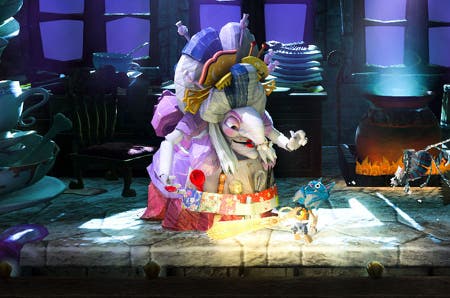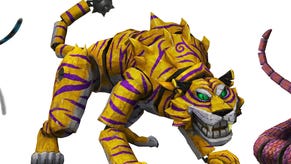The Ever-Shifting Stages of PS3 Exclusive Puppeteer
Tim Burton meets Japanese puppet theatre. Oh, and scissors.
In Puppeteer, you play a boy trapped in a wooden puppet without a head, fighting to escape a nightmarish world terrorised by a giant moon bear. Gavin Moore, the Brit leading development of the PlayStation 3 exclusive at Sony Japan Studio, admits it's a bit bonkers.
He calls it "quirky", "off-the-wall", "weird" and "strange", and it is. The game's unveiling during Sony's Gamescom press conference painted a dark picture of the 2D platformer: a curious Japan/UK culture clash that rekindles memories of Tim Burton and Terry Gilliam's signature work. But there's more to it than that. Watching the game being played pulls the curtain back on its neat ideas. All this focus on it being quirky and off-the-wall and weird and strange disguises this.
"I'm a really big fan of original 2D platformers," Moore says. "I love them. I think they're awesome. It's kind of a forgotten art. The only people who have really kept it alive are Nintendo. There's Rayman as well, but it's something we should definitely bring back full-scale."
Three things stand out to me about Puppeteer: the puppet boy, Kutaro, the cutting mechanic and the Japanese puppet theatre-inspired world in which the game is set.
Kutaro has, literally, lost his head. And so, as you work your way through the game, you'll find new heads, each with a special power. The first you'll come across is a skull head. Another I see is a hamburger head, which turns a sandwich into a burger on which Kutaro bounces to a previously impossible-to-reach platform. As you do. Then we see a spider head, which calls down a spider that whisks Kutaro off to a bonus stage.
In Puppeteer, your life is your head. If you're hit by an enemy, it falls off and rolls about. You then have three seconds to recover it before you die. It's the three-second rule, Moore says: the one we use to work out whether we can still eat the ice cream that's just dropped on the floor.
Managing your heads plays a central role. Moore imagines players will spend at least as much time exploring and hunting down every last one of them as they do completing stages, but for me it's how these will be incorporated into puzzle-solving that's of most interest. Using your hamburger head to turn a sandwich into a hamburger is the simplest example, designed to teach the player the mechanic during the tutorial. Moore promises more complex challenges further into the game.
Soon enough, Kutaro finds himself trapped in a web of cloth, but magical scissors are available to help free him. These magical scissors are even more important than the head mechanic; in fact, they are key to Puppeteer's gameplay. Not only do they act as the main weapon, but they're a transportation device of sorts. Using them propels Kutaro in the direction guided by the player: in straight directions, diagonals and circles. Puzzles will challenge the player to cut a variety of materials using the scissors. Cutting circles, Moore says, will be important, and you'll need to use the scissors, which become more powerful as Kutaro works his way through the game, to take down the many bosses.
But for me the star of this virtual show is the stage upon which it is delivered. Moore and his team at Japan Studio have animated a working theatre for use in the game. The camera remains fixed, freeing up CPU power to create sets that shift behind the on-stage actors.
It's an idea inspired by Japanese puppet theatre, called Bunraku. This traditional Japanese entertainment sees incredibly detailed puppets animated by hand by on-stage puppeteers without strings, with elaborate sets unfolding before the audience. "Everybody in the theatre would be glued on the acting, but the things that were really interesting to me were the set changing and the lighting changing and everything changing in real-time behind them," Moore says.
In the game, stages pop out of nowhere, and spotlights (there are 140 real-time lights as part of a true lighting rig) follow Kutaro around as you move about (one of the game's many lovely touches). Everything you see on screen has been animated by the developers, and it creates a handmade look with a tangible depth. Every 30 seconds or so, the set transforms. Cogs turn and thump, there's a new background. Thump, the camera shifts to top down. Thump, the camera shifts to vertical scrolling. Thump, we're back to side scrolling. "I want to make everything move," Moore says.
I'm a really big fan of original 2D platformers. I love them. I think they're awesome. It's kind of a forgotten art. The only people who have really kept it alive are Nintendo. There's Rayman as well, but it's something we should definitely bring back full-scale.
This idea of a video game version of Japanese puppet theatre was fused with western theatre - specifically Shakespeare, where the actors interact with the audience. So, in the game, an audience is watching the action, and it reacts to what you do. Do something spectacular and the audience will cheer and clap. If Kutaro is scared, the audience is scared. If Kutaro is surprised, they'll gasp. It's a lovely touch that adds a dash of the voyeur to the surreal in-game goings on.
Moore is at pains to tell us that Puppeteer is a full retail Blu-ray release, and is packed with content and varied locations and environments. This is probably a response to the reaction to the game's Gamescom showing, which left some thinking it was a PlayStation Network release. We've only seen one location so far, a dark castle, Moore points out, but once Kutaro escapes it the game opens up into ever brighter sets and presents more elaborate puzzles and platforming.
You might accuse Puppeteer of being a bit too odd for its own good, or looking a bit too much like LittleBigPlanet for comfort. But there are a number of unique mechanics here, chief among them the virtual theatre in which poor Kutaro is trapped. It doesn't look like it'll make hardcore 2D platformer specialists sweat, but Puppeteer is yet another example of Sony's willingness to invest in the weird and the wonderful. And for that, they should take a bow.




